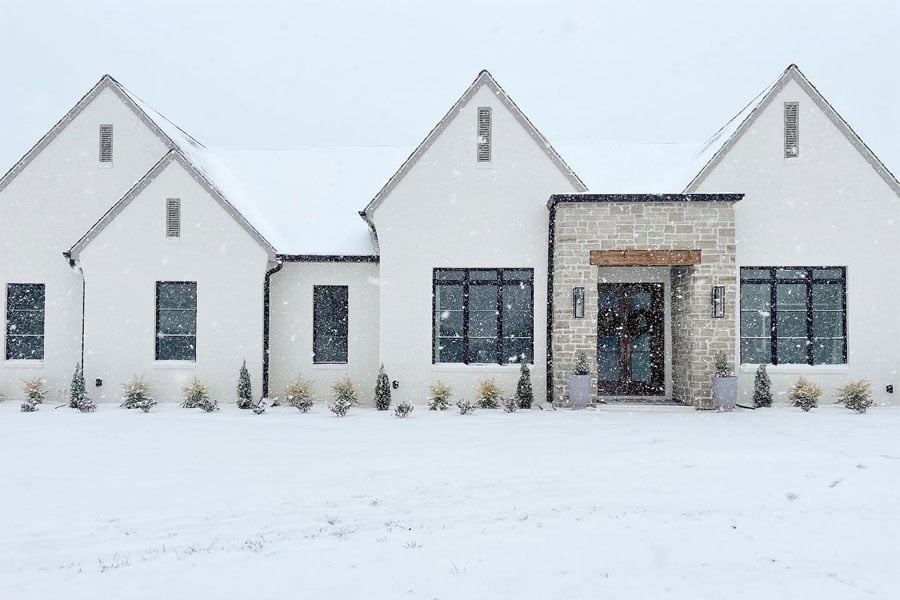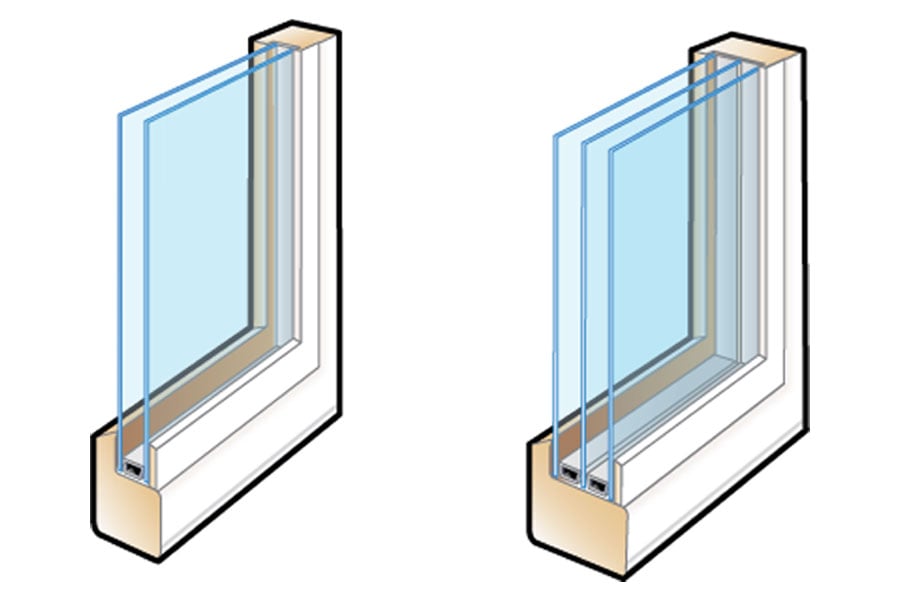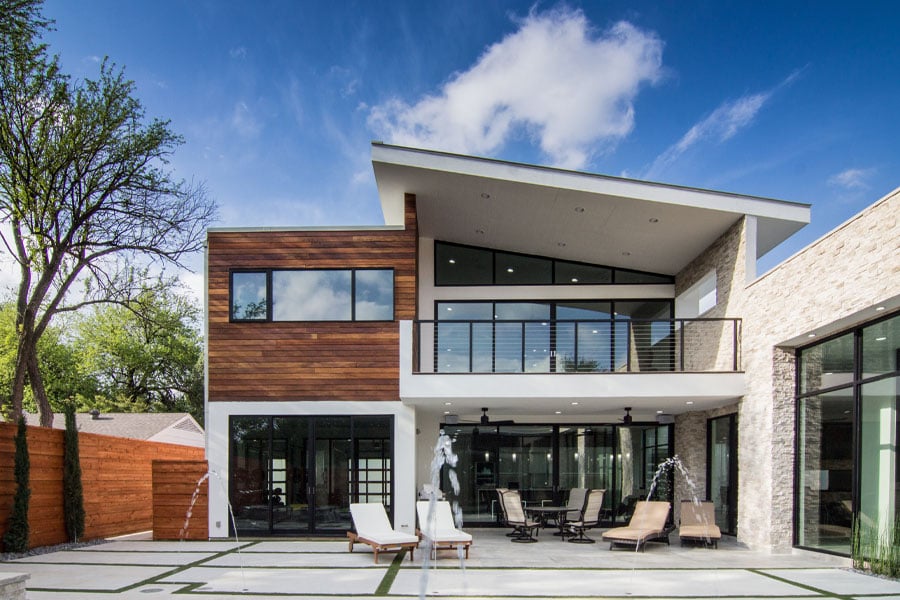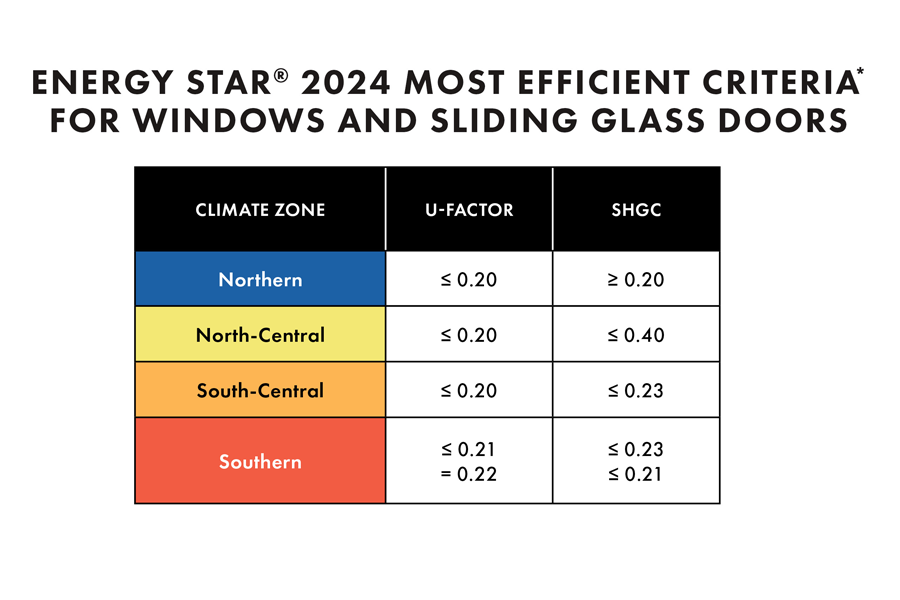Tips
How to pick out energy-efficient windows

How to pick out an energy-efficient window?
What types of windows are most efficient?

What is a double-pane window? A triple-pane window?
Glass construction is a key element of energy efficiency. The number of panes (sheets of glass) in a window and the air space in between are both important. Here’s what you need to know:
Single-pane glass includes only one sheet of glass between indoors and outdoors. This is the type of window glass you might find in an older home. It can be very beautiful, especially when it’s made with leaded glass, but it’s not energy efficient, which is why single-pane glass windows are often seen paired with storm windows on the exterior for additional insulation.
Double-pane, or dual-pane glass, includes two sheets of glass with an air space in between. The air space in our windows is generally filled with an argon-gas blend that’s denser than air and therefore improves insulation.* This type of window glass is better at insulating than single-pane glass and is a standard option on all our windows, as well as being required by most building codes.
Triple-pane glass goes one step further and includes an additional pane of glass and air space, making it the most energy-efficient glass type. In fact, A-Series triple-pane windows are recognized as ENERGY STAR® Most Efficient and certified to meet the rigorous level of energy efficiency required by Phius (Passive House Institute US). Triple-pane glass is an option on our A-Series and E-Series windows.

Talk like a pro: Thermal performance
Simply put, this is how well your window keeps heat (or energy) inside the home. If you want to understand this further, a U-Factor value is the measure used to determine how well a window or door prevents heat from escaping. The lower the number, the less heat is being lost. Understanding U-Factor values is helpful if you want to comparison shop between window brands.
For the most accurate measurement of performance, it’s very important to look at the U-Factor value for the whole window (called “whole unit performance”), not just the center of glass, which is a measurement you might come across. When comparing performance across manufacturers, make sure you have whole unit performance for all products you’re evaluating.
What is a low-emissivity glass (Low-E) coating?
One of the ways windows can be optimized for a specific climate zone is with a glass coating. Low-E glass coatings come standard with our windows. They are ultra thin, generally transparent, and are applied in various ways to help keep your home more comfortable. These coatings work by reflecting or absorbing heat. They can also be combined so different coatings are used on different panes of glass in order to create optimal performance by reflecting and absorbing heat as needed.
This is another advantage of dual- and triple-pane windows. In fact, one of the reasons triple-pane windows offer such superior performance is because the third pane offers an additional opportunity to include a Low-E coating. Here is what you need to know:
Low-E coatings for cold climates
Low-E4® glass is a good option in most climates, including climates with four seasons because it helps keep heat out in the warm months and in during the cold months. Depending on the conditions, it might make sense to consider a coating that will help heat up the home in the winter, or one that will help protect the home further from the sun’s intensity. Consider the following:
- SmartSun™ glass gives the benefits of Low-E while also helping to reduce 95% of harmful UV rays, which helps reduce fading to your furnishings and décor. Find this option on all our products.
- PassiveSun® glass is meant for climates where extensive heating is required. It helps you make the most of the sun’s warmth in heating your home and is available on all our products.
- HeatLock® technology is made for the northernmost climates. It creates a barrier that helps keep warming rays from the sun inside and works best in homes with whole-house air exchangers or dehumidifiers. It’s available on most of our products.
The combination of PassiveSun glass with HeatLock technology can be a good one in a Northern climate, because it can help insulate the home while also heating it with the power of the sun. This combination might be useful in a home that’s been designed according to passive house principles.
Low-E coatings for mild to hot climates
There are specific glass coatings that can help keep the sun from heating your home too much and even help reduce UV rays from coming into your home, including:
- Sun glass is ideal for a sunny climate. This coating helps reflect heat from the sun with a subtle tint that’s slightly darker than SmartSun glass.
- SmartSun™ glass works in both hot and cold climates by giving the benefits of Low-E glass while also helping to reduce 95% of the harmful UV rays. It can be a great choice in the sunny southern and western U.S.
The combination of SmartSun glass with Heatlock technology can be a good one in mild to hot climates. It helps with insulation while reducing the heat gained from the sun.
No matter your climate, your contractor, builder, or window dealer can help you select the best combination of coatings for your climate when you order.

Talk like a pro: Solar heat gain
Other factors affecting energy performance
As you’ve no doubt gathered, windows can be customized for energy-efficient performance in many different ways. Two additional selections that can have a big impact are grilles and breather tubes. You can forego grilles or select a more energy-efficient option, see below, but breather tubes are typically required at high altitudes. However, if you’re aware of the effect these features have, you can make other selections to counter their impact on performance.
Grilles: When they touch both panes of glass, these ornamental bars decrease efficiency by conducting energy and decreasing the insulating power of the air space. This is why the energy spacer bars available with A-Series windows and doors were designed in a way that avoids touching the glass. They’re a great option if you want the authentic look of full divided light grilles. But the most efficient choice of all is to skip grilles altogether.
Breather tubes: At elevations above 4,00 feet, these tubes prevent windows from becoming pressurized by allowing air to escape from the space in between window panes. Windows created for these elevations don’t include the argon-gas blend typically added to the air space in our windows, so they are less efficient overall. But don’t worry if you live at high altitude, you can lean into the selections highlighted above to help improve energy efficiency when breather tubes are required.
Want to save money on energy-efficient windows?
You’ve no doubt seen the ENERGY STAR® label on appliances and other products. It was created by the U.S. Environmental Protection Agency to make it easier for consumers to identify energy-efficient products. When applied to windows, it means the windows have met performance requirements to reduce the transfer of heat in a specific climate zone.
If you replace windows in an existing home with new windows that meet ENERGY STAR Most Efficient criteria for 2024, you can qualify for a tax credit covering up to 30% off the cost — with a maximum credit of $600 on windows.** This credit is available through 2032 and can also apply to doors. See below for criteria by climate zone.

Understanding energy-efficiency measures
To obtain ENERGY STAR certification on a window or door, a manufacturer must pass independent testing created by the non-profit National Fenestration Rating Council (NFRC), which establishes objective window, door, and skylight energy performance ratings to help homeowners, builders, architects, and others making purchasing decisions. NFRC testing measures and rates a window’s energy efficiency based on various factors, including U-Factor, SHGC, and Visible Transmittance. Here's what to make of these measures:
What it measures | U-factorHow well a product prevents heat from escaping | Solar heat gain coefficient (SHGC)The product's ability to block heat caused by sunlight | Visible transmittance (VT)The amount of light allowed through the window |
|---|---|---|---|
Performance impact | U-factorLower ratings mean better insulation | Solar heat gain coefficient (SHGC)Lower ratings mean less heat transfer | Visible transmittance (VT)Higher ratings mean more light |
Measurement ranges | U-factorScale of 0-1 | Solar heat gain coefficient (SHGC)Scale of 0-1 | Visible transmittance (VT)Scale of 0-1 |
**This is a summary of certain tax credit elements related to windows, skylights and doors as set forth in Section 25C of the Internal Revenue Code as modified by the Inflation Reduction Act of 2022, Public Law No. 117-169, which was signed by the President on August 16, 2022, which among other things, extends the current tax credits with amendments in Section 25C of the Internal Revenue Code on eligible property purchased and installed through December 31, 2032. Andersen bears no responsibility for determining whether a particular purchase or application qualifies for the tax credit. Further, Andersen does not intend to and is not providing legal or tax advice. Andersen recommends that purchasers consult with their own tax advisor and/or the IRS to determine whether products purchased for a particular application qualify for the tax credit.
